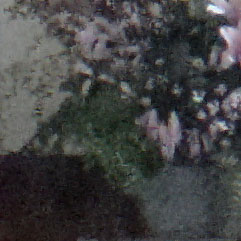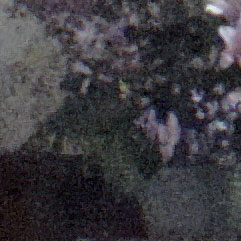Canon Digital IXUS 870IS / PowerShot SD 880IS ELPH
-
-
Written by Gordon Laing
Canon IXUS 870IS / SD 880IS vs Panasonic FX35 vs Sony T77 High ISO Noise

 |
 |
The lenses on each camera were adjusted to deliver the same field of view. Where coarse increments prevented an exact match using the zoom alone, the camera’s position was moved slightly back or forth to compensate. |
The image above was taken with the Canon IXUS 870IS / SD 880IS at a sensitivity of 80 ISO, with the lens zoomed-out to its widest equivalent of 28mm; the exposure was 1/4 at f3.5 and the original Large Fine JPEG file measured 3.35MB. The crops are taken from an area just to the right of the centre and presented at 100%.
At 80 ISO and viewed at 100%, the IXUS 870IS / SD 880IS sample is almost completely clean and packed with detail. At 100 ISO, there’s a very faint smattering of noise in areas of flat colour, although this is in line with most 10 Megapixel compacts and will only worry serious pixel peepers. Indeed the two other models here are arguably showing a slightly worse result at 100 ISO, with greater textures visible on the Panasonic FX35, and greater chroma artefacts on the Sony T77, especially in the flower pot.
At 200 ISO, there’s a fine sprinkling of noise visible throughout the image if you’re looking for it, although again the other models are also suffering a little – the FX35 has greater visible noise and the T77 shows smearing through greater noise reduction. At this point, the different noise reduction strategies adopted by each camera are becoming apparent and you may find one preferable to the others.
With the sensitivity increased to 400 ISO, these differences become more obvious. Panasonic is adopting a more hands-off approach, revealing the greatest noise, while Sony is going for higher noise reduction at the cost of smearing; Canon’s IXUS 870IS / SD 880IS is somewhere in-between. 400 ISO is probably the highest sensitivity you’d want to use with any of these cameras for images under close examination.
At 800 ISO there’s a big drop in quality across the board with a noticeable reduction in detail and an increase in artefacts – there’s still some detail in there, but this one’s for smaller prints only. 1600 ISO sees another dramatic reduction in quality and is best-used only for emergency use, or email. The top sensitivity of 3200 ISO drops the resolution down to just 2 Megapixels, but even then the results look very fuzzy – once again emergency use only.
So like its 10 Megapixel rivals here, the IXUS 870IS / SD 880IS is best used at 200 ISO or below, or 400 ISO at a push. At higher sensitivities, the quality greatly decreases, and is only suitable for smaller prints or emails / websites at reduced size. There’s no clear winner of the three cameras here in terms of high ISO performance, although pixel-peepers may prefer one noise reduction strategy over another.
Now head over to our Canon IXUS 870IS / SD 880IS Gallery to see some more real-life shots in a variety of conditions.
Canon IXUS 870IS / SD 880IS |
Panasonic Lumix DMC-FX35 |
Sony Cyber-shot DSC-T77 | ||
 |
 |
 | ||
80 ISO |
80 ISO not available |
80 ISO | ||
 |
 |
 | ||
100 ISO |
100 ISO |
100 ISO | ||
 |
 |
 | ||
200 ISO |
200 ISO |
200 ISO | ||
 |
 |
 | ||
400 ISO |
400 ISO |
400 ISO | ||
 |
 |
 | ||
800 ISO |
800 ISO |
800 ISO | ||
 |
 |
 | ||
1600 ISO |
1600 ISO |
1600 ISO | ||
 |
 |
 | ||
3200 ISO (at 2 Megapixels) |
3200 ISO (at 3 Megapixels) |
3200 ISO |




